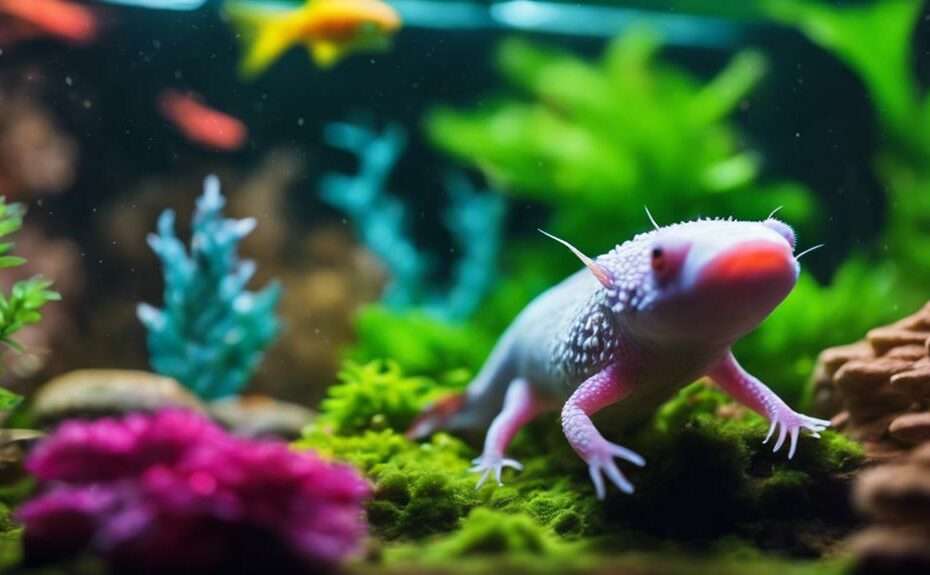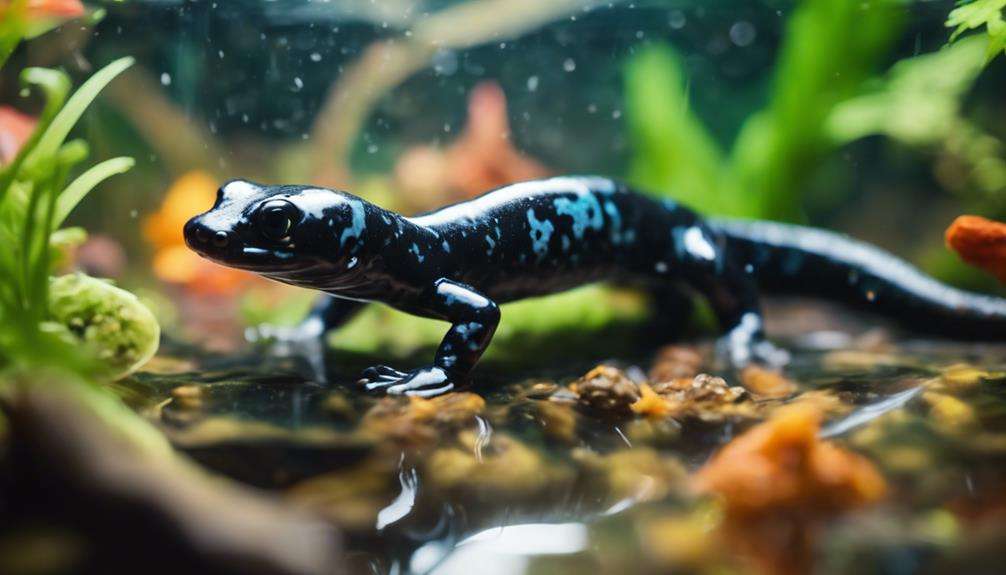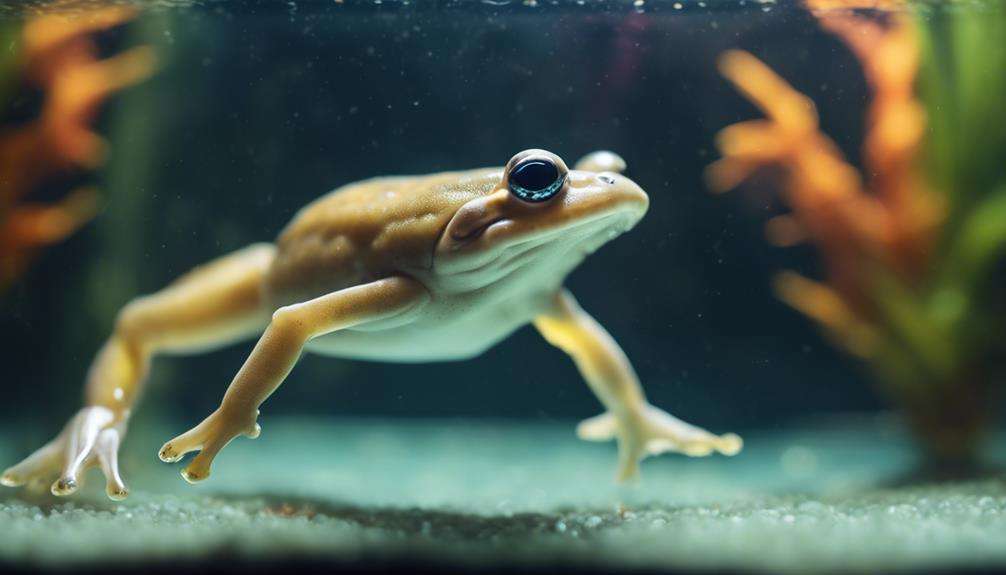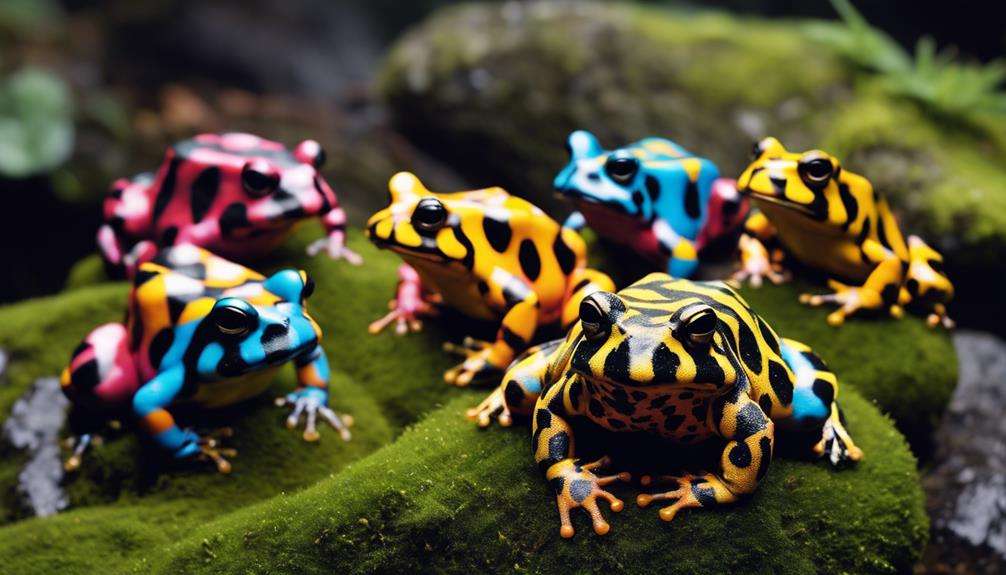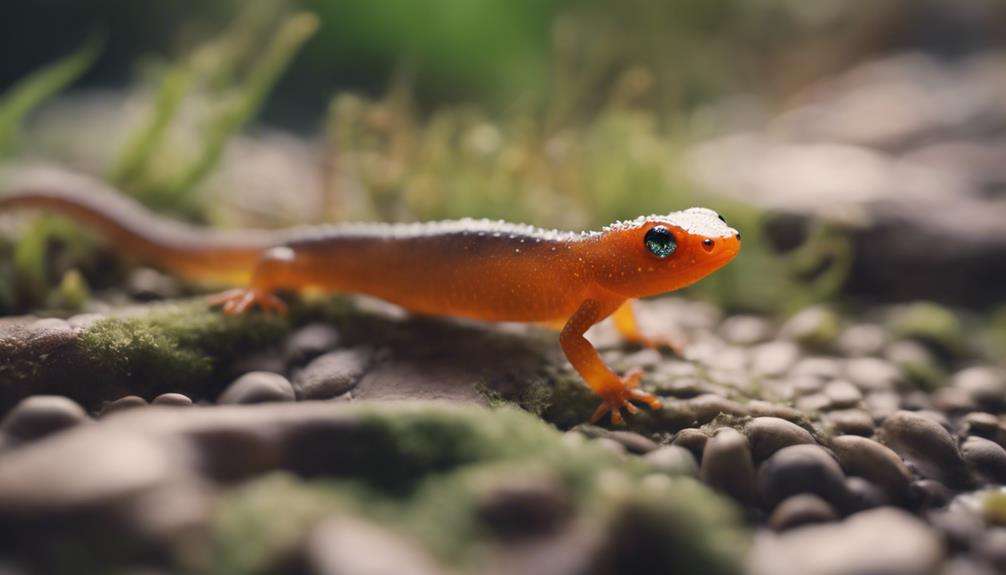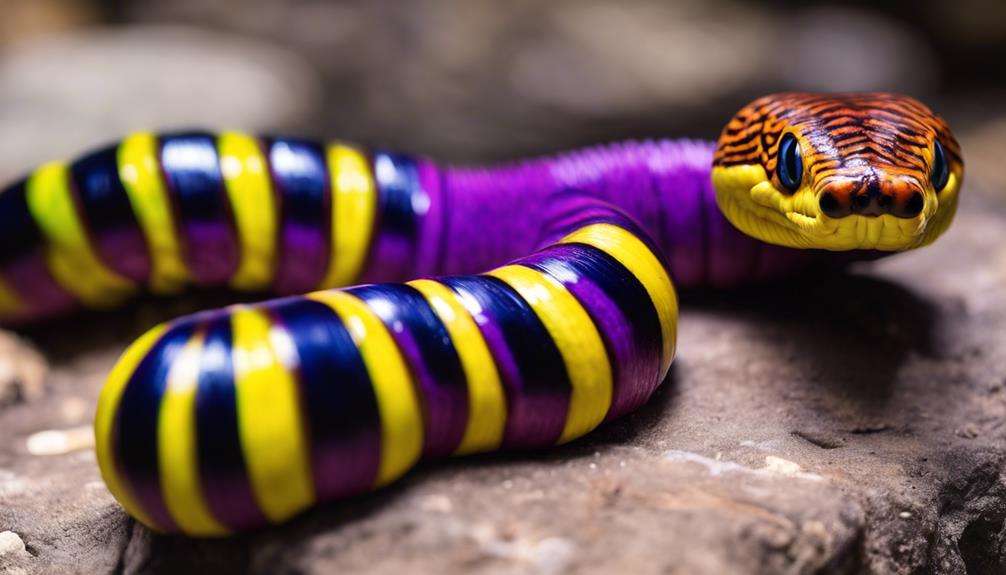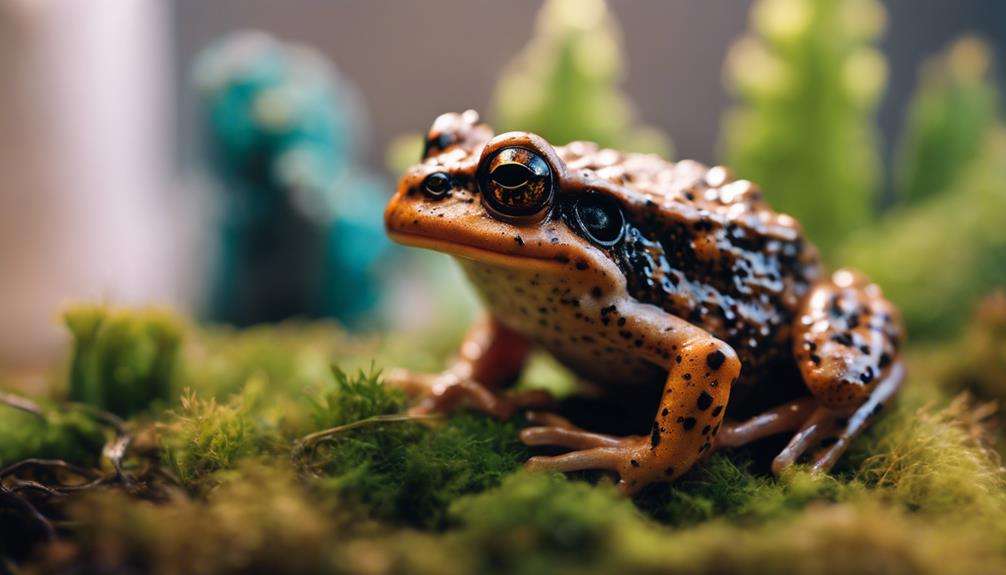When it comes to caring for axolotls in your aquarium, think of yourself as a meticulous gardener tending to delicate, underwater blossoms.
Ensuring the well-being of these unique creatures involves a delicate balance of factors. From creating a safe tank environment to monitoring water quality and providing proper nutrition, every detail plays a vital role in their health.
So, how can you master the art of axolotl care and create a thriving aquatic haven for these mesmerizing creatures?
Key Takeaways
- Provide a suitable tank environment with hiding spots and proper lighting for axolotls' well-being.
- Maintain optimal water conditions by regulating temperature and pH levels consistently.
- Feed a nutritious meat-based diet, hand-feed with care, and monitor health issues closely.
- Prevent bacterial infections and parasitic infestations through clean water, diet, and regular veterinary check-ups.
Axolotl Species Overview
Axolotls, commonly known as Mexican walking fish, are a fascinating neotenic species that uniquely retain their larval features throughout adulthood. Originating from Lake Xochimilco and Mexico City waterways in Mexico, these amphibians can reach sizes of up to 30cm and live for 10-12 years in captivity.
To ensure their well-being, it's crucial to house them in a tank size of at least 60cm. Their diet should primarily consist of meat-based foods to meet their nutritional requirements adequately. Additionally, providing Axolotls with normal daylight for 10-12 hours daily is essential for their health.
Understanding these basic characteristics of Axolotls will help you create a suitable environment for these captivating creatures in your aquarium. Remember, maintaining their specific habitat conditions is key to promoting their longevity and overall health.
Understanding Axolotl Behavior
As you observe your axolotl, pay attention to its behavior patterns, feeding preferences, and social interactions.
Axolotls are nocturnal hunters, displaying active behavior during the night.
Their curious 'gaping' behavior and graceful swimming style offer insights into their fascinating aquatic lifestyle.
Behavior Patterns
Nocturnal by nature, axolotls are most active during the night, displaying curious behaviors such as exploring their environment and investigating objects. Understanding their behavior patterns is crucial for their well-being.
Here are some key behaviors to look out for:
- Exploring Environment: Axolotls are curious creatures that enjoy investigating every nook and cranny of their tank.
- Investigating Objects: They often use their sensitive barbels to touch and explore objects in their environment.
- Territorial Behavior: Axolotls can exhibit territorial behaviors, especially when sharing a tank with other tank mates.
Feeding Preferences
Feeding preferences play a crucial role in understanding the behavior of these fascinating aquatic creatures. Axolotls are carnivorous, favoring a meat-based diet that includes a variety of foods such as axolotl pellets, bloodworms, and earthworms.
Feeding should be carried out at night since axolotls are nocturnal beings. When offering food, use tongs or tweezers to present bite-sized pieces for easy consumption. It's essential to monitor for signs of overfeeding and adjust the feeding schedule accordingly to ensure the axolotls' optimal health.
Social Interaction
When observing axolotls in an aquarium setting, it becomes evident that their social interactions primarily revolve around establishing dominance and territorial boundaries through body language cues. Axolotls aren't social animals and may show aggression towards tank mates.
Here are key points to consider regarding their social behavior:
- Solitary Nature: Axolotls prefer to live alone to avoid aggressive interactions with other tank mates.
- Territorial Behavior: They communicate through body language, such as gill waving, to mark their territory and establish dominance.
- Stress Issues: Aggressive interactions can lead to injuries and stress, impacting their overall health.
Understanding and respecting their solitary nature is crucial for creating a harmonious environment for axolotls in captivity.
Essential Housing Requirements
To adequately house axolotls in your aquarium, a tank size of at least 60cm is essential to meet their needs. Axolotls are best kept in tanks without gravel or pebbles to prevent ingestion risks, as they may mistakenly consume these substrates while hunting for food.
Providing hiding spots such as rocks, driftwood, and live plants is crucial for axolotls to feel secure and reduce stress levels. Additionally, ensuring a consistent 10-12 hours of normal daylight helps maintain a healthy environment for your axolotls.
It's vital to uphold proper tank cleanliness and water quality through regular maintenance routines. Monitoring and controlling factors like ammonia, nitrate, and nitrite levels, as well as pH balance, are essential for creating an ideal habitat for axolotls. By meeting these housing requirements, you can create a comfortable and safe living space for your axolotls to thrive in your aquarium.
Optimal Water Conditions
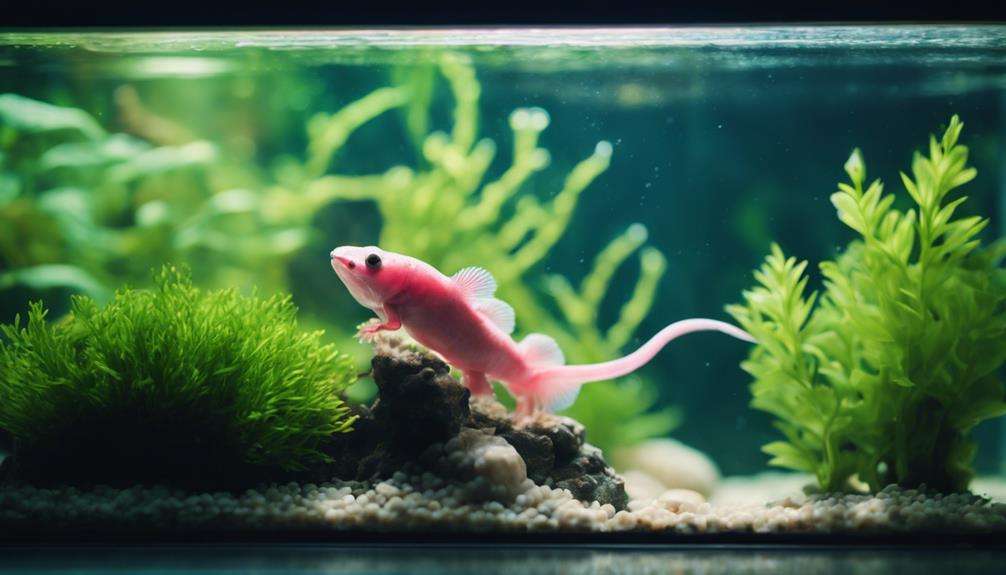
Maintaining optimal water conditions is crucial for the health and well-being of axolotls in your aquarium. To ensure your axolotls thrive, follow these key guidelines:
- Water Temperature: Keep the water temperature between 57-68°F to mimic their natural habitat and support their metabolic functions effectively.
- pH Levels: Maintain pH levels in the range of 6.5 to 7.5 to prevent any pH-related stress on your axolotls and promote overall well-being.
- Aquarium Conditioner and Water Depth: Treat tap water with a reliable aquarium conditioner before adding it to the tank to remove harmful chemicals. Ensure the water depth is slightly more than the length of your axolotl to provide ample swimming space without causing stress.
Proper Feeding and Nutrition
For optimal health and nutrition of your axolotls in the aquarium, it's essential to ensure they're fed a well-balanced diet rich in meat-based foods. Axolotls thrive on a diet that includes axolotl pellets, live worms, and frozen bloodworms. Hand-feeding using tongs or tweezers is recommended to prevent accidental ingestion of substrate, ensuring your axolotls consume their food safely. Offer food in small, bite-sized pieces to facilitate consumption and digestion.
Due to their nocturnal habits, feed your axolotls at night to align with their natural feeding behavior. Regularly monitor your axolotls for any signs of fungal infections, heat stress, or ammonia burns. These conditions can impact their health, so prompt detection and treatment are crucial. By maintaining a nutritious diet and attentively observing your axolotls, you can help prevent common health issues and support their overall well-being in the aquarium.
Dealing With Common Health Issues
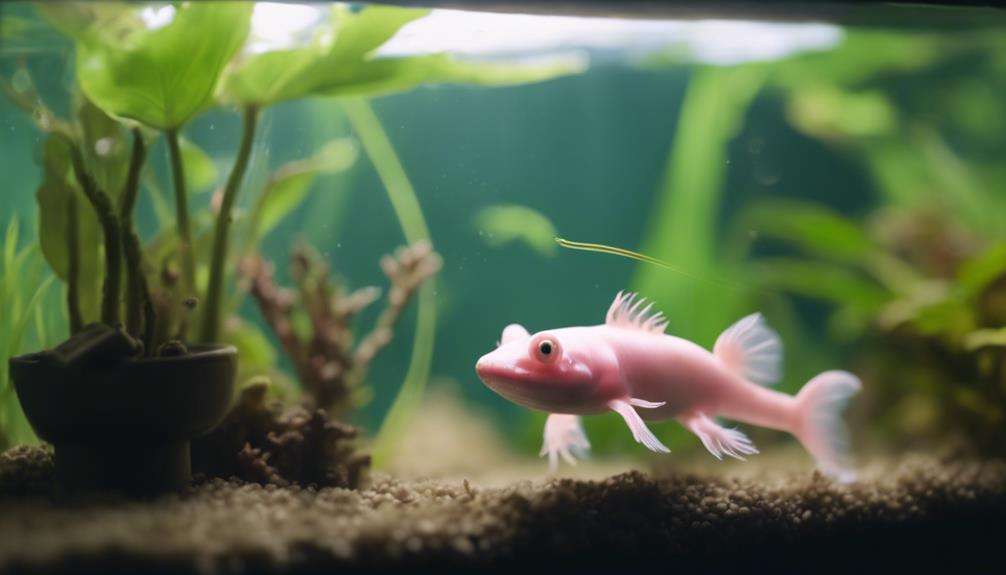
When caring for axolotls, it's crucial to be vigilant for signs of fungal infections, like a white film on their skin or gills. Prompt treatment with suitable remedies such as Pimafix can help prevent the spread of fungal infections.
Additionally, monitor their health closely for symptoms of bacterial diseases, and promptly address any signs to maintain the well-being of your axolotls.
Preventing Fungal Infections
To prevent fungal infections in your axolotls, ensure water quality, reduce stress, and promptly address any injuries they may sustain.
Maintaining clean water conditions, providing a proper diet, and creating a stress-free environment are crucial in preventing fungal issues.
Here are some key steps to help you prevent fungal infections:
- Monitor Water Quality: Regularly test and maintain appropriate water parameters to prevent fungal growth.
- Minimize Stress: Create a calm and comfortable habitat for your axolotls to reduce the likelihood of fungal infections.
- Address Injuries: Promptly treat any wounds or injuries to prevent them from becoming entry points for fungal pathogens.
Treating Bacterial Diseases
Treatment of bacterial diseases in axolotls involves administering antibiotics as prescribed by a veterinarian to address conditions such as red leg disease, fin rot, and ulcerative dermatitis. Bacterial diseases in axolotls can result from poor water quality, stress, or injuries. Symptoms of these diseases may include redness, inflammation, ulcers, or tissue decay.
To treat bacterial infections, it's crucial to maintain clean water conditions, provide a proper diet, and ensure a stress-free environment for your axolotl. Prevention is key in avoiding bacterial diseases, so regularly check water parameters, keep the tank clean, and handle your axolotl gently to reduce stress levels. If you notice any symptoms of bacterial diseases, promptly seek advice from a veterinarian for appropriate treatment.
Managing Parasitic Infestations
Parasitic infestations in axolotls are commonly caused by worms, flukes, or protozoa. To manage these infestations effectively, consider the following:
- Symptoms: Watch out for signs such as weight loss, lethargy, bloating, and abnormal behavior in your axolotl.
- Fecal Examinations: Regular fecal examinations by a veterinarian are crucial for detecting and treating parasitic infections promptly.
- Treatments: Treat parasitic infestations with medications prescribed by a vet. Ensure to follow the vet's instructions carefully for the best results.
Maintain optimal water quality and a clean tank environment to prevent parasitic infestations in axolotls. Regular monitoring and swift action can help keep your axolotl healthy and thriving.
Legal Considerations for Ownership
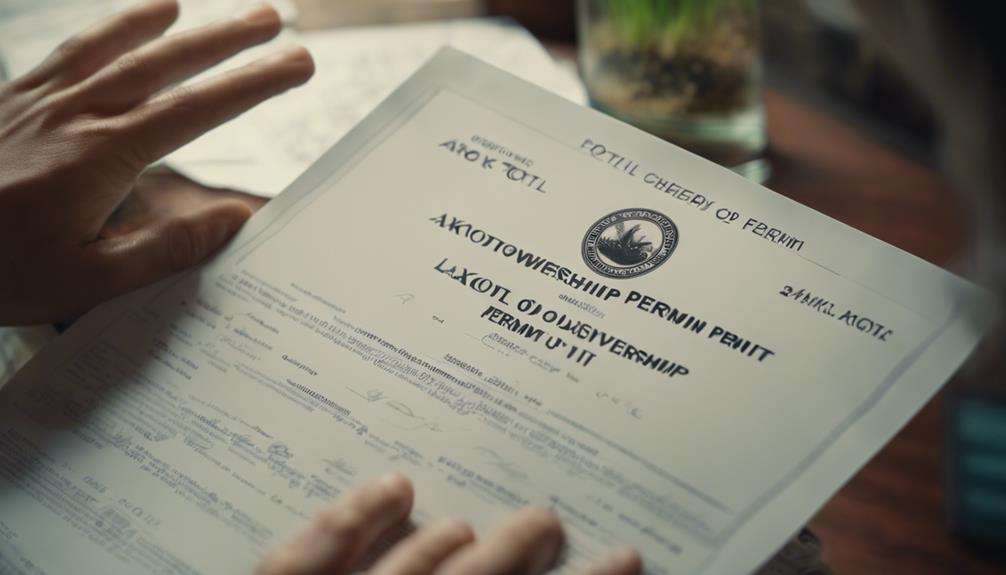
When considering owning an axolotl, it's imperative to be aware of the legal restrictions that may apply in your state. Axolotls are illegal to own in states such as California, Maine, New Jersey, and Virginia.
In New Mexico, ownership is permitted, but importing axolotls from other states is prohibited. Before acquiring an axolotl as a pet, always check local exotic pet laws to ensure compliance with regulations.
These laws are in place to protect both the axolotls, which are critically endangered in the wild due to habitat loss, and the ecosystems they inhabit. To help conserve the species, it's crucial to ensure that axolotls are responsibly sourced.
While the average cost of an axolotl ranges between $30 and $80, it's essential to purchase from reputable breeders or rescue groups to support ethical and sustainable practices in the trade. By understanding and adhering to legal considerations, you can enjoy owning an axolotl while contributing to their conservation.
Selecting and Purchasing Your Axolotl
To ensure the well-being and origin of your axolotl, it's essential to purchase from reputable breeders or rescue groups. When selecting and purchasing your axolotl, consider the following:
- Reputable Breeder: Opt for breeders known for their ethical practices and healthy axolotls. A reputable breeder will provide you with detailed information about the axolotl's background, health status, and care requirements.
- Health Status: Prioritize axolotls that show no signs of illness or distress. Ensure the axolotl you choose is active, has clear skin, and exhibits normal behavior to guarantee a healthy addition to your aquarium.
- Cost Range and Color Morphs: Axolotls come in various color morphs, influencing their prices. The average cost ranges between $30 and $80, depending on the rarity of the color morph and the age of the axolotl. Consider your budget and preferences when selecting the perfect axolotl for your aquarium.
Exploring Similar Axolotl Species
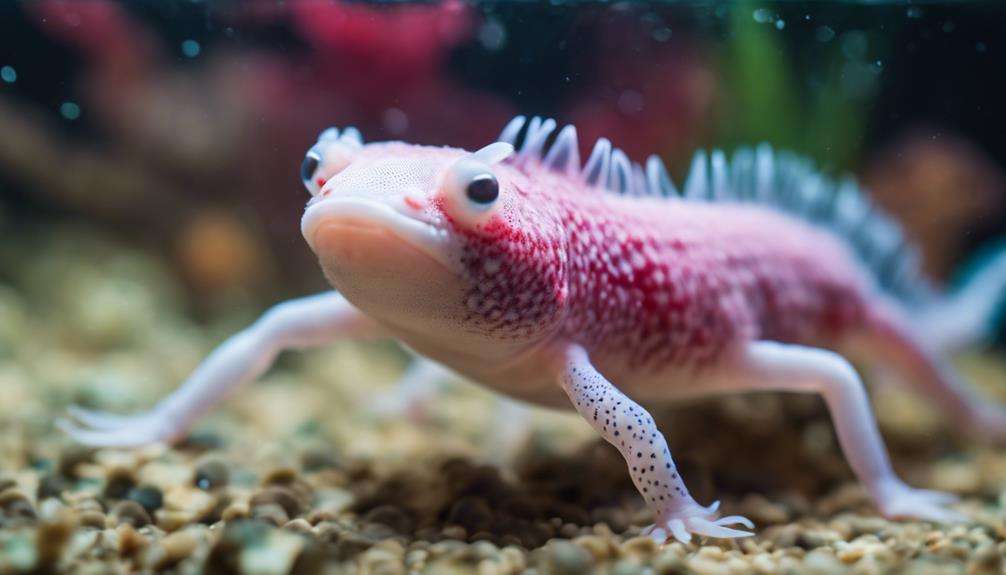
After considering the selection and purchase of your axolotl, it's valuable to explore other similar species that share characteristics with these unique aquatic creatures. Among the salamander species, Tiger salamanders stand out for their potential size, reaching up to 14 inches, which is larger than most axolotls. Leopard geckos, unlike axolotls, are terrestrial reptiles with distinct care requirements. Fire belly newts, another related species, can be easily identified by the bright orange or red markings on their bellies, a stark contrast to the smooth skin of axolotls.
While these species share a connection with axolotls, it's crucial to note that housing them together may not be advisable due to potential genetic issues. Each species has specific needs and behaviors that must be considered when keeping them in captivity. Understanding the differences in care requirements, such as the semi-permeable skin of Ambystoma mexicanum compared to other species, is essential to ensure the well-being of these unique creatures.
Frequently Asked Questions
How Do You Keep an Axolotl in an Aquarium?
To keep an axolotl in an aquarium, ensure a suitable tank setup with hiding spots. Feed them a varied diet on a schedule. Monitor water quality, maintain proper temperature, avoid tank mates. Handle gently, provide decor options, and regularly check their health.
What Do Axolotls Need to Survive in a Tank?
To survive in a tank, axolotls need proper tank temperature, water quality, a consistent feeding schedule, tank decor like rocks and plants, adequate lighting, a tank size of at least 60cm, gentle handling, and no aggressive tank mates.
What Should You Not Put in a Axolotl Tank?
You should not put small gravel or sharp decorations in an axolotl tank. Avoid tank mates that stress them out. Ensure proper filtration, adequate space, and temperature control. Opt for safe substrates, non-toxic plants, and maintain ideal conditions for their well-being.
What Do Axolotls Love in Their Tank?
In their tank, axolotls love having various hiding spots like rocks, driftwood, and live plants for security and enrichment. Including these tank decorations allows them to explore, hide, and feel secure in their environment.
Conclusion
As you navigate the intricate waters of axolotl care, remember that each decision you make shapes the delicate ecosystem within your aquarium.
Just as the axolotl gracefully glides through its watery domain, your dedication and attention to detail will ensure a thriving environment for these unique creatures.
Embrace the symbiotic relationship between keeper and axolotl, and witness the beauty of harmony flourishing in your aquatic world.
